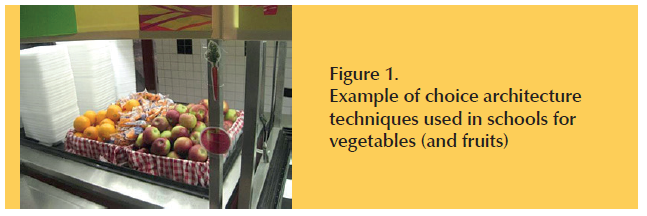Effects of choice architecture and chef-enhanced meals on the selection and consumption of healthier school foods
School meals can make important contributions to the diets of children, and interventions that improve the selection and consumption of vegetables can have important health implications1,2. Some research suggests that improving palatability should be prioritized to increase selection and consumption of vegetables3, while other studies suggest that just modifying the food environment to “nudge” students towards the healthier vegetables (i.e. “choice architecture” techniques) may be sufficient4,5. For example, a study by Wansink and colleagues found that giving vegetables attractive names, such as x-ray vision carrots, can lead to increases in children’s vegetable selection after only one exposure6.However, it was unclear if the effectiveness of choicearchitecture techniques diminishes over time or if there would be a benefit to combining both a chef-based approached to improve palatability with choice architecture.
Chef-Based Approach and Choice Architecture to promote F&V
Research was conducted to evaluate the short-term (3 months) and long-term (7 months) exposure to a professional chef and extended daily exposure (4 months) to choice architecture on school vegetable selection and consumption using data from the Modifying Eating and Lifestyles at School (MEALS) study. The MEALS study was a randomized control trial in two urban, low-income school districts in Massachusetts among students in grades 3-8. Selection and consumption were measured at three time points to assess baseline levels, after schools were randomized to a professional chef or control status, and then again after schools were randomized to receive a professional chef alone, choice architecture alone, both the chef and choice architecture combined, or control status.
Increased vegetable consumption in the chef intervention schools
The schools that received a professional chef received both training in culinary skills and culturally appropriate recipes that were cost effective and incorporated fresh or frozen produce, prepared with seasonings without added salt or sugar (recipes can be found at http://www.projectbread.org/reusable-components/accordions/download-files/school-food-cookbook.pdf).
When examining the short-term impact of the chef-based, more palatable meals, there was a significant increase in vegetable selection in the chef intervention schools compared with the control schools. However, because students had only limited exposure to the new vegetables, overall vegetable consumption did not change. With long-term exposure to the more palatable, chef-inspired meals, again vegetable selection was significantly greater in the chef intervention schools compared with the control schools. Additionally, vegetable consumption increased by about 30 percent in the chef intervention schools; students consumed roughly 60 percent of their vegetable dish in the chef intervention schools compared with less than 30 percent consumed in the control schools. This translated to students consuming an additional 0.15 cups of vegetables per day or 0.75 cups of vegetables per week.
Choice Architecture increase vegetable selection but not their consumption
The choice architecture techniques used in the schools included providing vegetables at the beginning of the lunch line, as well as displaying them in attractive containers and offering options at the cash registers (Figure 1). Additionally, visual images and posters promoting vegetables were prominently displayed.

When examining the impact of extended daily exposure to choice architecture, vegetable selection significantly increased in the choice architecture intervention schools compare with the control schools. However, overall consumption of vegetables did not change, and students in the schools with choice architecture techniques discarded approximately 80 percent of their vegetable dishes. Interestingly, when examining the schools that had both the chef-enhanced food and the choice architecture techniques, there was no additional benefit for vegetable consumption beyond the impact of the chef intervention alone.
Improving palatability should be prioritized to increase F&V consumption
Both improved palatability and choice architecture techniques provide benefits, especially to increase the selection of vegetable consumption in schools. This may help provide children with repeated exposure to new vegetables, which can increase the likelihood that children will consume them. However, improving the taste of vegetables appears to be a more effective long-term solution to increasing vegetable consumption in schools.
References
- U.S. Department of Agriculture, Food and Nutrition Service, Office of Analysis, Nutrition, and Evaluation (USDA/FNS). Child Nutrition Program Operations Study, Second Year Report: Executive Summary. R. St. Pierre, M.K. Fox, M. Puma, F. Glantz, and M. Moss, and Project Officer, J. Endahl. Alexandria, VA. June 1992.
- United States Department of Agriculture. School Lunch and Breakfast Cost Study-II: Summary of Findings. http://www.fns.usda.gov/ora/menu/published/CNP/FILES/ MealCostStudySummary.pdf.
- Story M. The third School Nutrition Dietary Assessment Study: findings and policy implications for improving the health of US children. J Am Diet Assoc. 2009;109(2 Suppl):S7-13.
- Wansink B, Just DR, and McKendry J. Lunch Line Redesign. http://www.nytimes. com/interactive/2010/10/21/opinion/20101021_Oplunch.html?_r=0.
- Wansink B. Environmental factors that increase the food intake and consumption volume of unknowing consumers. Annu Rev Nutr. 2004;24:455-479..
- Wansink B, Just DR, Payne CR, Klinger MZ. Attractive names sustain increased vegetable intake in schools. Prev Med. 2012;55(4):330-332..
